Hood Bosch: types, subtleties of selection and installation

The kitchen is a place where close people gather for breakfast, lunch and dinner. But when the stove is in operation, dangerous carbon monoxide (carbon monoxide) and formaldehyde are released. These gaseous toxic substances quickly spread throughout the apartment and harm the health of family members. Installing a hood will solve this problem.

Peculiarities
The German company Bosch has long established itself as a manufacturer of high quality electronics. Household appliances are created strictly in accordance with the European quality standard, therefore, there is no doubt about the long service life of electrical appliances. The company regularly releases new models with a large number of options and a user-friendly interface. The hoods offered by this manufacturer are subjected to various tests. The wear resistance of all parts and elements is checked. Bosch motor motors, like many other components, are manufactured in Germany.

Despite their power, Bosch hoods run almost silently. The assortment includes various design options, so choosing a model for any kitchen interior is not difficult.
Views
There is no specific classification of hoods. When buying, usually the appearance of the porcelain and its technical parameters are taken into account. There is a large selection of cooker hoods in specialized stores.
Let's consider their main types and find out what are their similarities and differences.
- Suspended hoods are popular due to their low price. The design cannot be called powerful, its purpose is air filtration. The circulating hood filters the air, and once it is purified, it is thrown back into the room. The set often includes a charcoal filter. Suspended hoods are usually installed in small kitchens, where equipment perfectly draws out all harmful vapors and odors from the air. You can increase the efficiency of this structure by connecting it with an air duct to the ventilation shaft.


A flat hood (visor) is also often found in stores. Such devices are considered a type of suspended hoods. If you are interested in this type of construction, we recommend that you pay attention to the Bosch Serie 4 DUL 63 CC 20 WH suspended hood. The models of Bosch suspended hoods practically do not differ from each other, their power is approximately 129-146 W, the maximum productivity is 230-350 cubic meters. m / h.
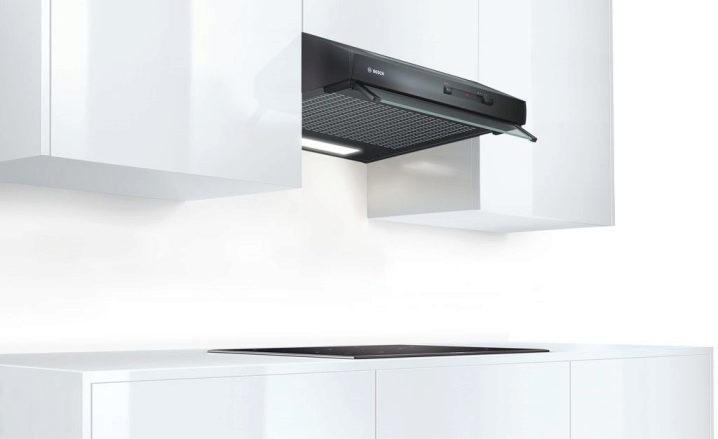
- Embedded. Such devices are built into a wall cabinet. This way the kitchen does not become cluttered and maintains a neat appearance. Built-in devices are much more powerful than outboard ones, since these models are equipped with two motors. Such designs remove carbon monoxide vapors and odors much faster, but due to the operation of the motors, the noise level increases. There are options for hoods that are built into the worktop. They are installed on both sides of the stove. This installation option is expensive, and problems with the installation of the system may also arise. The built-in hood "Bosch Serie 4 DFM 064 A 51 IX" is an excellent option. There is practically no noise from the motor, it can be easily built into a 60 cm wide cabinet, so finding the right furniture for it is not difficult.
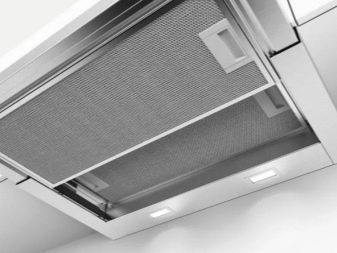

- Dome. Outwardly, it resembles a hood or a dome that hangs above the stove, therefore such structures are also called kitchen hoods and chimney hoods. There is an external resemblance to the fireplace exhaust system.Such structures greatly clutter up the space, so it is better to install them in large kitchens. Hoods are considered powerful, so they are installed not only at home, but also in cafes and restaurants.

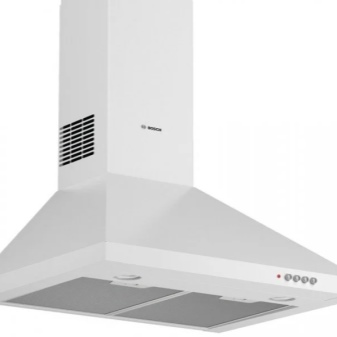
- Housewives prefer inclined fireplace-type hoods. They are much more convenient to use: the view of the hob is increased, they have a low noise level. In addition, the tilting range hood takes up much less work space than a conventional dome hood. The cost of an inclined structure is quite high, but it is much more convenient to use it. Hood for fireplace DWP64CC50R is made of stainless steel, the umbrella is made in the form of a truncated pyramid. Another option is DWK065G20R. The inclined hood has an interesting design and high productivity - 550 cubic meters. m / h. The power of the model is 216 W.

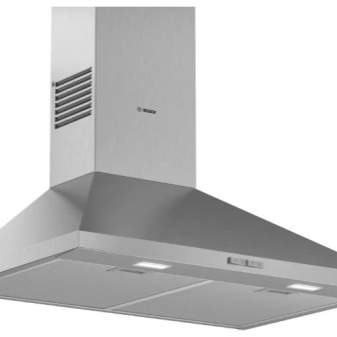
- Telescopic. This type is also called pull-out. During its operation, it is possible to adjust the operation of the additional panel, it increases the air absorption surface. There are island telescopic hoods. These models are not wall-mounted and cannot be built into a kitchen cabinet. The island structure is fixed to the ceiling. The device is suitable for kitchens in which the workplace is located in the middle of the kitchen as an "island". If necessary, the additional panel can be extended or retracted using the control panel.


- The cost of island hoods is quite high compared to other types of designs. Manufacturers offer original designs, such as an inverted glass hood or disguised as a chandelier. Of course, you need to take into account the fact that this device is part of the interior. It should look harmoniously with furniture and appliances. If you have a spacious kitchen and the place for preparing dishes is in the center (not adjacent to the wall), then an island hood is an excellent solution. The island construction "Bosch Serie 8 DIB091K50" has a modern design. Grease filters with a clogging indicator are easy to clean in the dishwasher. The hood is equipped with a touch panel, lamps and lighting.




Materials (edit)
Hoods are made of various materials: glass, ceramics, plastic, stainless steel, aluminum. The cost of the device depends not only on the technical characteristics, but also on the material. Glass, ceramic hoods are considered expensive compared to plastic or stainless steel structures.




Many housewives like glass hoods, they fit neatly into the interior and seem less bulky. But taking care of such a device is not easy, because after cooking, splashes and other contaminants remain on the fireproof panel, which are conspicuous on the glass. You will have to clean the surface frequently. In addition, special detergents must be used for glass. It is not recommended to wash the surface with an iron brush, as it will leave scratches on the glass.


Almost all budget models are made of steel. Stainless steel structures look less impressive, but they work no worse than glass or ceramic hoods. Bosch offers a wide range of devices in both stainless steel and glass.
Colour
This manufacturer produces hoods in white, silver and black. Silver devices are in demand because they are less noticeable and keep their tidy look longer.



Components
Any hood is a complex mechanism in which the motor creates an air draft, due to which the polluted air is removed from the room. The device contains a variety of parts that need to be changed periodically. There is a grease filter in every hood. It traps grease particles and protects the motor blades and air duct surface from contamination. Fat filters are disposable and reusable. Disposable ones are made on the basis of synthetic products (non-woven, synthetic winterizer, acrylic). In structure, they resemble cloth napkins.Manufacturers install them in cheaper models of suspended flat structures. It is necessary to periodically check the hood and change this filter. Some housewives wash and use it again, but this is not worth doing.

Reusable filters are included with expensive range hoods. There is no need to change them; it is enough to clean the cassette with detergent. The filter looks like a mesh with a metal frame. Basically, parts are made from aluminum and stainless steel. The charcoal filter is designed for hoods that maintain a recirculation mode (air is cleaned and returned to the room). Coal is an excellent sorbent (a substance that absorbs harmful gases and vapors), so it copes well with the problem of air pollution with carbon monoxide. The element is installed behind the grease filter.

The carbon filter often has to be replaced with a new one, the cost of the part is 250-2000 rubles. If you change it regularly, it is quite expensive. The work of the entire structure depends on its state. A dirty carbon filter will reduce the throughput, power and performance of the unit. Its useful life can be increased by leaving the hood to work for 5 minutes after cooking. This time is enough for the filter to dry out of moisture and vapors.


How to choose and install?
When choosing a hood, certain features must be taken into account.
- Dimensions. The width of the appliance must be greater than or equal to the width of the cooker. Only under this condition will the hood extract gas and steam. You can install a telescopic hood with adjustable extension of the additional panel.
- Mode of operation. Almost all devices operate in the exhaust and recirculation mode. If you have a spacious kitchen, you will have to install a ventilation duct; in this mode, the hood will work much more powerful. If the kitchen is small in area, then feel free to choose a hood with a recirculation mode. The performance of such a model will be sufficient to eliminate odors.
- Control. The hood can be controlled using touch control (electronic). There are sensors on the panel, which usually have indicator lights. Push-button control assumes the presence of buttons, with the help of which the modes are changed and the commands "turn on" and "turn off" are executed. Sliding devices have sliders on the bottom of the hood.
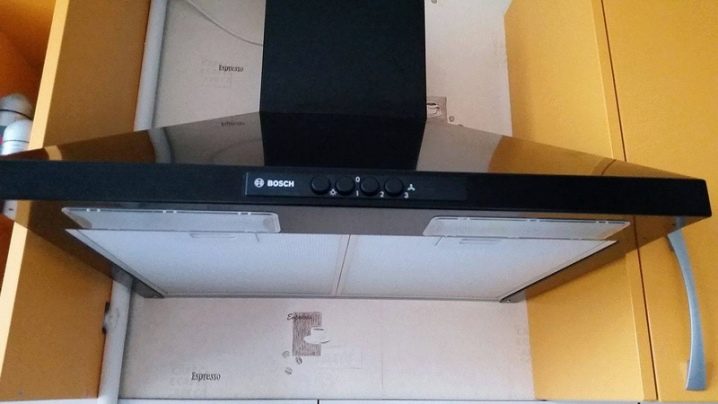
Hoods with an automatic shutdown timer are very popular lately. The device operates both in normal mode (the time and operating modes are selected by a person independently) and in timer mode (the time is set after which the device automatically turns off).
- Performance. Exhaust performance is a value that shows how much air a technician removes per hour. For a small kitchen, an apparatus with a capacity of 600 cubic meters is suitable. m / h. If the kitchen is large, then you should choose a hood with a higher performance. But the higher the power of the device, the more noise from it. Powerful modern models are available with a sound-absorbing unit. In such a device, the motor is placed inside a rubber block, and there is practically no noise from it.
- Noise level. The noise level is approximately 40-80 dB. To avoid annoying sound, give preference to hoods with a level of 40-60 dB.

Reviews of Bosch technology are generally positive. It is very easy to operate the device, regulate its operating modes. Most devices have high performance.
Now let's talk about how to install the hood yourself.
- Use a tape measure to measure the height on the wall on which the structure will be fixed. Be sure to take into account that the installation height for the electric stove should be 65-75 cm. Near the burners, structures are installed at a height of 75-85 cm. These rules apply to all types of hoods, except inclined ones.The distance from the bottom panel of the inclined hood to the electric stove should be 36-67 cm, and to the gas stove - 56-67 cm.
- Use a level and draw a straight horizontal line. At this height, the lower part of the body will be fixed. Measure the length of the device, put this length on the line. Find the midpoint of the line segment, then draw a straight vertical line.
- Now measure the height of the structure. If the pipe rests against the ceiling, then part of it must be cut off. Consider installation restrictions.

- Measure the distance from the bottom of the device to the mount. Set this distance on the vertical line. Draw a horizontal line through this notch (point).
- The height and length of the hood are now marked on the wall. Also on the wall, mark the places where the structure will be attached.
- With a drill or punch, make holes for the dowels, then screws will be screwed into them.
- It is better to start the installation from the top mounts. The position of the device is horizontally aligned and finally fixed.
- Attach the corrugation or duct to the ventilation opening of the unit on one side and to the ventilation shaft on the other.

Repair
Any equipment breaks down over time, a kitchen hood is no exception.
Let's consider the main problems and how to fix them.
- Doesn't draw air. We've already talked about filters earlier. Grease filters should be washed every 3 weeks. The charcoal filter is changed every 5-6 months. Modern models have a built-in sensor that lights up and informs that it is necessary to replace the element. Often the fan does not extract air due to dirty filters. Rinse and replace them in the device. If you checked the filters, cleaned them, and the hood still pulls poorly, then perhaps a vacuum has formed in the apartment. In this case, it is enough to simply ventilate the room, the problem should be eliminated.
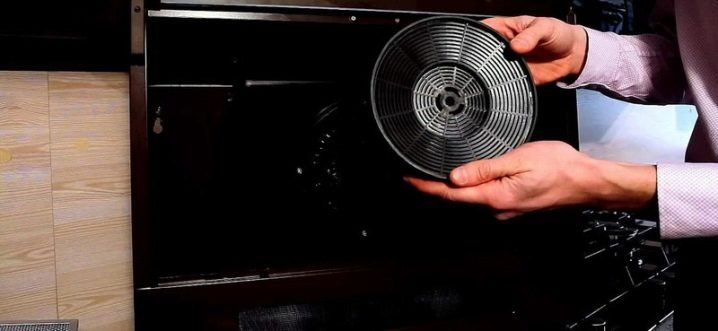
- If there is no draft in the ventilation duct, then, accordingly, the hood will also not stretch. It is very simple to check the draft - bring a lighter or a lit match to the ventilation hole, the flame should tighten. This problem can be corrected by installing an electric exhaust fan.
- Loud noise and extraneous sounds. Powerful machines are very loud. If the device hums, "tapping" is heard, then first of all check the mounts. Even a small gap can cause extraneous sounds. Fasten the device tightly; you can also lay foam rubber between the wall and the device. There are times when the device hums and does not start. If the fuse breaks down, it must be replaced.
- Bulbs do not work. If the light does not turn on, then the bulb itself may have burned out. We'll have to purchase a new one, disassemble the structure and replace it.


The cooker hood not only removes odors, it helps to maintain the health of all family members. The device draws out polluted air, removes carbon monoxide from the apartment. The Bosch cooker hood will keep your kitchen clean and fresh for years to come.
For an overview of the Bosch telescopic hood, see the following video.













The comment was sent successfully.